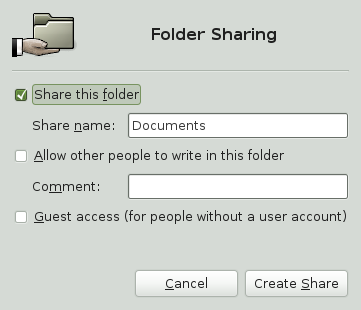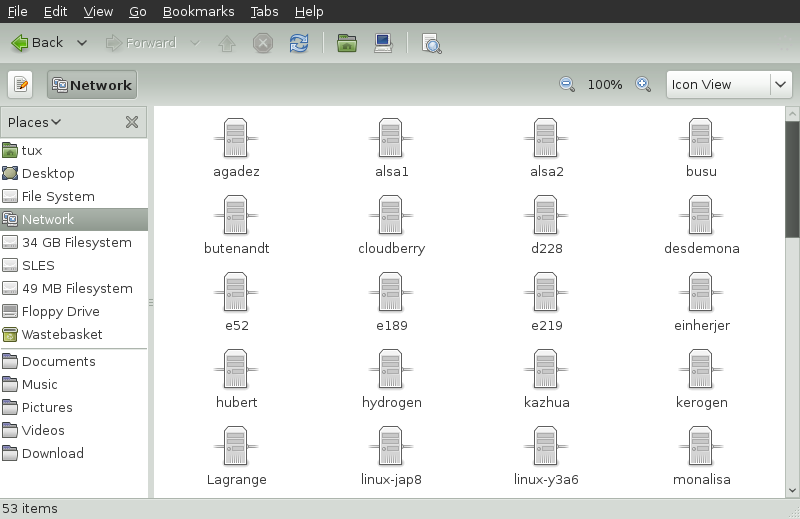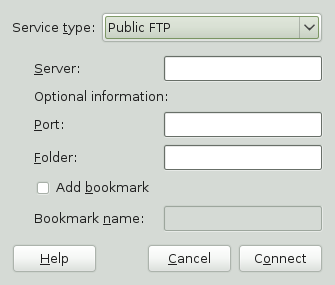Contents
From your desktop, you can access files and directories or certain services on remote hosts or make your own files and directories available to other users in your network. openSUSE® offers the following ways of accessing and creating network shared resources.
- Network Browsing
Your file manager, Nautilus, lets you browse your network for shared resources and services. Learn more about this in Section 5.3, “Accessing Network Shares”.
- Sharing Folders in Mixed Environments
Using Nautilus, configure your files and folders to share with other members of your network. Make your data readable or writable for users from any Windows or Linux workstation. Learn more about this in Section 5.4, “Sharing Folders”.
- Managing Windows Files
openSUSE can be configured to integrate into an existing Windows network. Your Linux machine then behaves like a Windows client. It takes all account information from the Active Directory domain controller, just as the Windows clients do. Learn more about this in Section 5.5, “Managing Windows Files”.
- Configuring and Accessing a Windows Network Printer
You can configure a Windows network printer through the GNOME Control Center. Learn how to configure this in Section 5.6, “Configuring and Accessing a Windows Network Printer”.
You can connect to a network with wired and wireless connections. To view your network connection status, click . In the area of the main menu, the icon shows your network connection status. Click the icon to open the YaST Network Settings module. You can use this module to configure your network setup method or to edit your network card configuration.
Whether and to which extent you can use file sharing and network browsing on your machine and in your network highly depends on the network structure and on the configuration of your machine. Before setting up either of them, contact your system administrator to make sure that your network structure supports this feature and to check whether your company's security policies permit it.
Network browsing, be it SMB browsing for Windows shares or SLP browsing for remote services, relies heavily on the machine's ability to send broadcast messages to all clients in the network. These messages and the clients' replies to them enable your machine to detect any available shares or services. For broadcasts to work effectively, your machine must be part of the same subnet as all other machines it is querying. If network browsing does not work on your machine or the detected shares and services do not mmeet with your expectations, contact your system administrator to ensure that you are connected to the appropriate subnet.
To allow network browsing, your machine needs to keep several network ports open to send and receive network messages that provide details on the network and the availability of shares and services. The standard openSUSE is configured for tight security and has a firewall that protects your machine against the Internet. To adjust the firewall configuration, you would either need to ask your system administrator to put your interface into the internal zone or to tear down the firewall entirely (depending on your company's security policy). If you try to browse a network with a restrictive firewall running on your machine, Nautilus warns you that your security restrictions are not allowing it to query the network.
Networking workstations can be set up to share folders. Typically, files and folders are marked to allow users remote access. These are called network shares. If your system is configured to access network shares, you can use your file manager to access these shares and browse them just as easily as if they were located on your local machine. Your level of access to the shared folders (whether read-only or write access, as well) is dependent on the permissions granted to you by the owner of the shares.
To access network shares, open Nautilus and click from the pane. Nautilus displays the servers and networks that you can access. Double-click on a server or network to access its shares. You might be required to authenticate to the server by providing a username and password. Common network shares are SFTP accessible resources (SSH File Transfer Protocol) or Windows shares.
Sharing and exchanging documents is a must-have in corporate environments. Nautilus offers you file sharing, which makes your files and folders available to both Linux and Windows users.
Before you can share a folder, you must enable sharing on your computer. To enable sharing:
Start the YaST from the main menu.
Enter the root password.
Click .
Click .
Click , then click .
To configure file sharing for a folder:
Open Nautilus.
Right-click a folder, then select from the context menu.

Select .
If you want other people to be able to write to the folder, select . To allow access for people without a user account check .
Click .
If the folder does not already have the permissions that are required for sharing, a dialog appears. Click .
The folder icon changes to indicate that the folder is now shared.
![[Important]](admon/important.png) | Samba Domain Browsing |
|---|---|
Samba domain browsing only works if your system's firewall is configured accordingly. Either disable the firewall entirely or assign the browsing interface to the internal firewall zone. Ask your system administrator about how to proceed. | |
With your openSUSE machine being an Active Directory client, you can browse, view and manipulate data located on Windows servers. The following examples are just the most prominent ones:
- Browsing Windows Files with Nautilus
Use Nautilus' network browsing features to browse your Windows data.
- Viewing Windows Data with Nautilus
Use Nautilus to display the contents of your Windows user folder just as you would for displaying a Linux directory. Create new files and folders on the Windows server.
- Manipulating Windows Data with GNOME Applications
Many GNOME applications allow you to open files on the Windows server, manipulate them and save them back to the Windows server.
- Single-Sign-On
GNOME applications, including Nautilus, support Single-Sign-On. This means that to access other Windows resources, such as Web servers, proxy servers or groupware servers like MS Exchange, you do not need to reauthenticate. Authentication against all these is handled silently in the background using the username and password you provided on login.
To access your Windows data using Nautilus, proceed as follows:
Open Nautilus and click in the Places pane.
Double-click .
Double-click the icon of the workgroup containing the computer you want to access.
Click the computer’s icon (and authenticate if prompted to do so) and navigate to the shared folder on that computer.
To create folders in your Windows user folder using Nautilus, proceed as you would when creating a Linux folder.
Being part of a corporate network and authenticating against a Windows Active Directory server, you can access corporate resources such as printers. GNOME allows you to configure printing from your Linux client to a Windows network printer.
To configure a Windows network printer for use through your Linux workstation, proceed as follows:
Start the GNOME Control Center from the main menu.
Select +.
Select +.
Select +.
Open the SMB Browser with and select a workgroup, a server and the printer. Either enter the authentication credentials or choose to be prompted for authentication each time when accessing the printer. Click .
Choose the printer's manufacturer and the printer model from the list and select a driver. The one that is marked with normally produces the best results. Proceed with and provide a name, a description and a location for the printer. Click .
Adding a printer requires root privileges, so you must enter the root password as the final step to adding it.
To print to the Windows network printer configured above, select it from the list of available printers.

